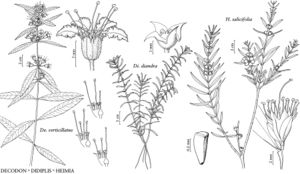Didiplis
Atlantic J. 1: 177. 1833.
| Taxon | Illustrator ⠉ | |
|---|---|---|
 | Decodon verticillatus Didiplis diandra Heimia salicifolia |
Herbs, annual or short-lived perennial, aquatic or amphibious, 0.5–4 dm, glabrous throughout. Stems erect, creeping, floating, or submerged, irregularly branched, frequently rooting at nodes when submerged. Leaves usually opposite, sometimes subalternate or whorled, dimorphic; sessile or subsessile; blade linear when submerged, narrowly elliptic to lanceolate when aerial, base truncate when submerged, tapered when aerial. Inflorescences indeterminate, flowers solitary, axillary, opposite. Flowers sessile, actinomorphic, monostylous; floral-tube perigynous, broadly campanulate; epicalyx segments absent; sepals 4, broadly deltate, 1/2 floral-tube length; petals 0; nectariferous tissue present at ovary-floral tube junction; stamens 2–4; ovary 2-locular; placenta globose; style sturdy, relatively short; stigma capitate. Fruits capsules, walls thin and dry, indehiscent, splitting irregularly. Seeds ca. 25, narrowly obovoid to fusiform, slightly convex-concave; cotyledons ± complanate.
Distribution
c, e United States
Discussion
Species 1.
Didiplis is easily overlooked due to its undistinguished aspect. In the past it has been included in Ammannia, Lythrum, and Peplis. Molecular evidence now strongly supports the sister relationship of Didiplis to Rotala (J. A. Morris et al. 2007).
Selected References
None.